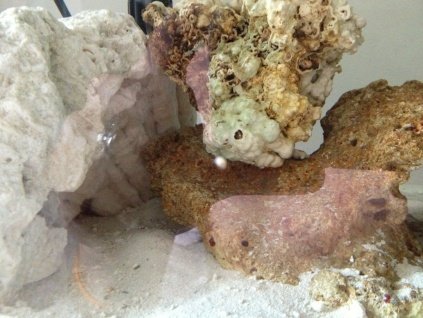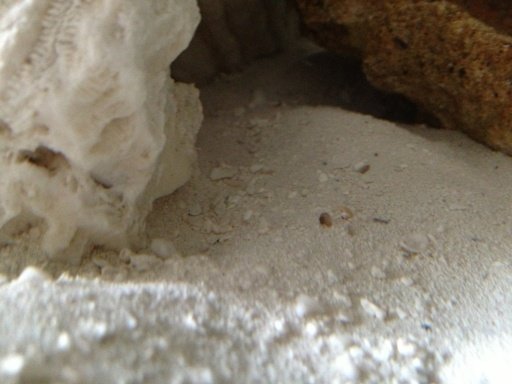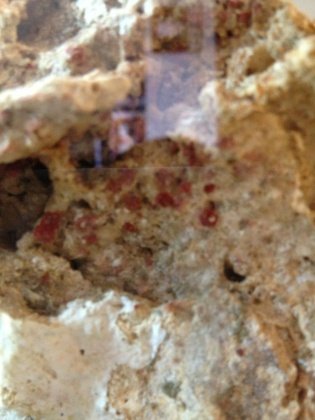You are using an out of date browser. It may not display this or other websites correctly.
You should upgrade or use an alternative browser.
You should upgrade or use an alternative browser.
Baby snail????
- Thread starter Rybo
- Start date
The friendliest place on the web for anyone with an interest in aquariums or fish keeping!
If you have answers, please help by responding to the unanswered posts.
If you have answers, please help by responding to the unanswered posts.
herp_mommy
Aquarium Advice Addict
could be a snail. The red stuff looks like cyano.
It's hard to tell from a picture. Coralline algae should look hard and smooth. It's hard to tell when it first starts on rocks though.
When it starts out on glass or plastic it looks rather like crazy colored lichen because it grows in rings. On a rough textured rock it takes quite a while for the coralline to fill in the texture, and take on its trademark smooth surface. There are so many colors that it can be hard to ID as well. C A survives by being cryptic. It makes itself not look like algae, and grows where other algae cannot. It also makes itself unpalatable by incorporating huge amounts of calcium into its cell structure.
Most forms of cyano sit loosely on the surface and will vacuum away easily, but there are some that attach more firmly. Those that attach firmly typically never really make more than a super thin layer.
For algae control I use a 1/4 or 3/8 inch hose for a vacuum. If I am doing a water change at the same time I just let it run int whatever bucket I am catching the old water with. Otherwise I rig it up so the the other end of the hose will run into a piece of filter floss in a net sitting over my sump. This way I can vacuum to my heart's content, and get as much algae out as possible.
Using the smaller hose allows me to really direct the suction where I want it. If I have hair algae I may actually use my fingers to pluck algae, and let the siphon suck it up. This type of siphon will help remove all but the most stubborn cyanos, and will do wonders to remove diatoms and the random bits of detritus that get stuck in pockets in the rocks.
Before my recent move I was having a terrible case of Old Tank Syndrome, and I could not get my nitrates or algae to go away. With the move I got rid of the sand bed in my display tank, and did an almost 50% water change. That coupled with kalkwasser/vinegar dosing has destroyed the nitrates and algae with no livestock losses during the move. In fact, they all look happier than ever.
When it starts out on glass or plastic it looks rather like crazy colored lichen because it grows in rings. On a rough textured rock it takes quite a while for the coralline to fill in the texture, and take on its trademark smooth surface. There are so many colors that it can be hard to ID as well. C A survives by being cryptic. It makes itself not look like algae, and grows where other algae cannot. It also makes itself unpalatable by incorporating huge amounts of calcium into its cell structure.
Most forms of cyano sit loosely on the surface and will vacuum away easily, but there are some that attach more firmly. Those that attach firmly typically never really make more than a super thin layer.
For algae control I use a 1/4 or 3/8 inch hose for a vacuum. If I am doing a water change at the same time I just let it run int whatever bucket I am catching the old water with. Otherwise I rig it up so the the other end of the hose will run into a piece of filter floss in a net sitting over my sump. This way I can vacuum to my heart's content, and get as much algae out as possible.
Using the smaller hose allows me to really direct the suction where I want it. If I have hair algae I may actually use my fingers to pluck algae, and let the siphon suck it up. This type of siphon will help remove all but the most stubborn cyanos, and will do wonders to remove diatoms and the random bits of detritus that get stuck in pockets in the rocks.
Before my recent move I was having a terrible case of Old Tank Syndrome, and I could not get my nitrates or algae to go away. With the move I got rid of the sand bed in my display tank, and did an almost 50% water change. That coupled with kalkwasser/vinegar dosing has destroyed the nitrates and algae with no livestock losses during the move. In fact, they all look happier than ever.
Similar threads
- Replies
- 1
- Views
- 98
- Replies
- 4
- Views
- 356
- Replies
- 1
- Views
- 151
- Replies
- 0
- Views
- 423
- Replies
- 15
- Views
- 591



